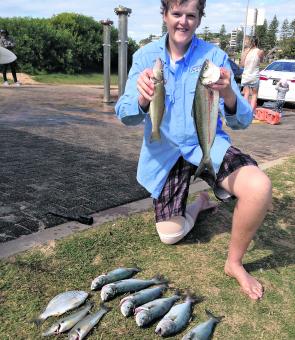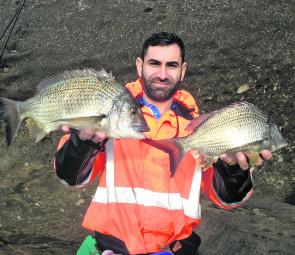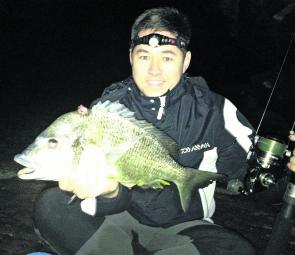It’s a trevally fest off the ocean rocks, in the harbour and even some beaches at present! Like the Australian salmon, these hard fighting fish were 1 of the first species I became enthralled with as a teenager. Salmon are known for their strength, stamina and spectacular acrobatics. Trevally are also known for their strength and stamina, but they have the ability to damage line on structure like pylons, rock ledges, kelp and anything that is abrasive. They teach you to play fish out well in this sort of country.
As a table fish, they are a delight — pan-fried, grilled, barbecued, and wow! What a perfect sashimi fish when they are just around that legal to kilo size. Their flesh is sweet and light at that size range.
Catching the larger models from 1.2kg up to the occasional 3kg fish is a great experience. Their eating qualities diminish greatly with fish over 2kg though. The flesh gets drier, has a stronger flavour, and along the backbone it often gets a honeycombed, potholed look caused by a parasite, which is unsightly to look at and can put diners off. Those sections can be cut out of the flesh though, and as far as I know does not present any health risks. Normally I prefer to release the larger trevally, taking a photo if they warrant it.
All the headlands on the ocean rocks, and most rocks and wharves in the harbour, are producing some to lots of trevally. A whippy tipped rod like the 3-6kg Live Fibre from Wilson, or a 10 or 12’ MT4144 coupled with a Daiwa Segate Hyper 3000 or Alvey 625B and 4-6kg line make for great balanced outfits for these fish. Rig with a light ball sinker from 00-1 with a 1/0 Mustad 92554 baited with pilchard halves, peeled Endeavour or banana prawns, fished in a wet bread berley off a deep rock ledge with a water depth of at least 3m.
Off the ocean rocks, sudsy white water will spread the berley, and in the harbour a wharf or ledge with that depth at least should get you onto some trevally. Please seek the right advice before venturing onto the ocean rocks if you’re a beginner though.
The snapper are on the chew at the moment. Distance casting can be better than fishing in the washes with a berley trail, simply because of the abundance of trevally. Squid strips seem to be working best, but I seldom take just 1 bait type. I don’t like to be caught out with these often-fussy feeders. Fish baits like salted striped tuna, salted slimy mackerel and tailor can be added.
South and North Curl Curl, Dee Why, Long Reef, and the front of the pool at Mona Vale have some nice plate size and occasional 50cm fish available.
June is a good month for big kings, and kings in general. If you can find them, small salmon up around that 1kg size make sensational kingie live baits. Float them out under a balloon or free swim them on 24-37kg tackle. The traditionally used live yellowtail is also getting a few. Extra large sea gars are always a good choice, but will be out of season in the near future, so stock up!
Lures like the iCatch 12 stick bait in pink or white works well, and is a longer plastic than the others. It is getting close to matching the length of a large sea gar. Try Bluefish at Manly, South and North Curl Curl, and when you can get there, generally because of crowds, North Whale records some good catches of kings.
In Sydney Harbour, there are good fish at North Dobroyd Point, Manly Point and Georges Head. Some big groper are getting around too. A report of an 11kg fish, and a client with his very first groper of just under 9kg was a great introduction to this species.
Rock blackfish are present on virtually all headlands. Little Bluey in Manly and Freshwater Pool has a few. Try North Curl Curl boulders, Long Reef has so many spots to choose, Narrabeen Head in flat conditions and south Avalon rocks from 50m past the pool to the big gutter are all worth a throw.
The beach for me is relaxing fishing. The high energy of rock fishing test my senses, wits and concentration levels to the max for safety and, more importantly, for my clients. Fishing the beach allows a more placid approach without the inherent dangers of ocean rock fishing.
There are still some dangers involved in ocean beach fishing though. I watched an angler walk down to the water’s edge to maximise his casting distance while wearing waders. Some big sets were on their way towards him. I could see a potentially bad situation about to occur. The sets were big shore dumping waves, as a result of the deep gutter in front of him, and the waves were in excess of 1.2m. He got bowled over, his waders filled up with water, and he could not get up.
He was starting to get dragged out to sea and I quickly got rid of my bait bucket and belt, carry bag and rod, and assisted him. This person was in a bad situation and could have easily drowned. If you wear waders (they are great for keeping dry and warm in winter), but they have their dangers. I can give you more comprehensive advice, but just avoid going too close to the water’s edge when wearing them. Besides, a massive cast off the beach in a lot of situations is not necessary.
Okay, here’s what’s biting. The tailor are on in the early mornings and late afternoons. The bigger run of 1-2kg fish are busiest in the evenings. Have you ever caught a big tailor in the surf on 6kg line? It’s an experience you have to try. Savage bite, strong fighting fish and some fast action, because they are generally in fairly large schools, so if you have a few anglers casting out ganged pilchards you can hold a school of these ferocious feeders.
The salmon are becoming more prolific and will become the chief beach predator as the water cools off. They’re being caught on ganged pilchards. If you can get them cheap enough, medium sea gars are the number 1 bait for tailor in my opinion. Some 20-25 to the kilo is what you want, as it makes them practical and affordable. As they are quite thin at this size, I generally drop down to a 3/0 set of 3 to 4 gangs.
The bycatch of the odd flathead and stud bream is coming in as well. Manly, Curl Curl, Dee Why, mid to North Narrabeen, Bilgola Beach, and Avalon beaches are producing. Whiting are still available and will be until about mid-July. Mid July — when 95 per cent of whiting fishos have given up on them! Just keep fishing until the water temperature drops below 19 degrees.
The bream have been better in the evenings, using fish baits like half pillies, tailor and mullet strips, and pipis. Bream are a fairly common bycatch when whiting fishing with tubeworms or beachworms, especially in the evenings.
My advice for this month is that even if the conditions appear to be mild, have the warm weather gear on hand regardless. If a cooler sou’ west wind springs up, you won’t be caught out.
Bell0615_1
Jack Maitland with a great bag of tailor, salmon, whiting and tarwhine. These species and more are available on the beaches with the right methods and timing.
Bell0615_2
Rab Ajami with a couple of nice bream to 1.5kg. On the day there was 2 rock blackfish to 2kg caught as well. This is what you can expect this month.
Bell0615_3
Jonathon Walsh with a ripper bream caught and released in the evening from the harbour shores near Balmoral. Notice the unusual growth above its head.
Reads: 1390






